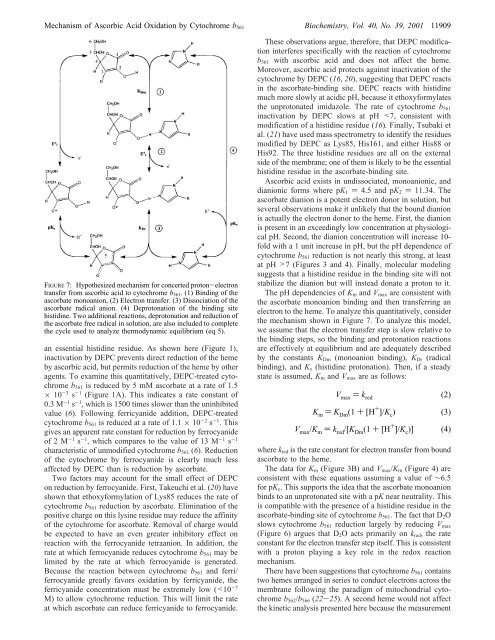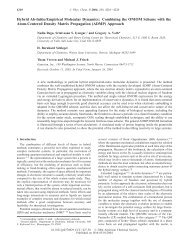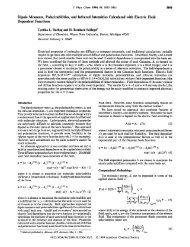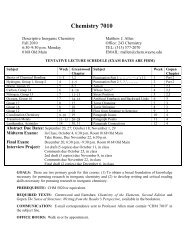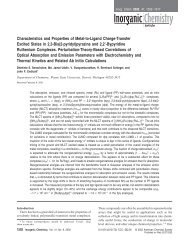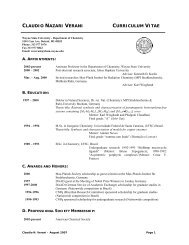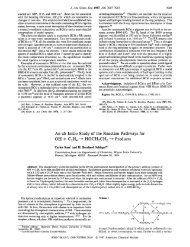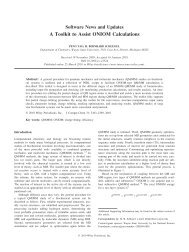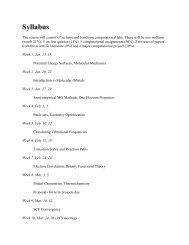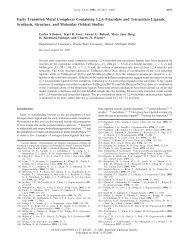Mechanism of Ascorbic Acid Oxidation by Cytochrome b561
Mechanism of Ascorbic Acid Oxidation by Cytochrome b561
Mechanism of Ascorbic Acid Oxidation by Cytochrome b561
Create successful ePaper yourself
Turn your PDF publications into a flip-book with our unique Google optimized e-Paper software.
<strong>Mechanism</strong> <strong>of</strong> <strong>Ascorbic</strong> <strong>Acid</strong> <strong>Oxidation</strong> <strong>by</strong> <strong>Cytochrome</strong> b 561 Biochemistry, Vol. 40, No. 39, 2001 11909<br />
FIGURE 7: Hypothesized mechanism for concerted proton-electron<br />
transfer from ascorbic acid to cytochrome b 561 . (1) Binding <strong>of</strong> the<br />
ascorbate monoanion, (2) Electron transfer. (3) Dissociation <strong>of</strong> the<br />
ascorbate radical anion. (4) Deprotonation <strong>of</strong> the binding site<br />
histidine. Two additional reactions, deprotonation and reduction <strong>of</strong><br />
the ascorbate free radical in solution, are also included to complete<br />
the cycle used to analyze thermodynamic equilibrium (eq 5).<br />
an essential histidine residue. As shown here (Figure 1),<br />
inactivation <strong>by</strong> DEPC prevents direct reduction <strong>of</strong> the heme<br />
<strong>by</strong> ascorbic acid, but permits reduction <strong>of</strong> the heme <strong>by</strong> other<br />
agents. To examine this quantitatively, DEPC-treated cytochrome<br />
b 561 is reduced <strong>by</strong> 5 mM ascorbate at a rate <strong>of</strong> 1.5<br />
× 10 -3 s -1 (Figure 1A). This indicates a rate constant <strong>of</strong><br />
0.3 M -1 s -1 , which is 1500 times slower than the uninhibited<br />
value (6). Following ferricyanide addition, DEPC-treated<br />
cytochrome b 561 is reduced at a rate <strong>of</strong> 1.1 × 10 -2 s -1 . This<br />
gives an apparent rate constant for reduction <strong>by</strong> ferrocyanide<br />
<strong>of</strong>2M -1 s -1 , which compares to the value <strong>of</strong> 13 M -1 s -1<br />
characteristic <strong>of</strong> unmodified cytochrome b 561 (6). Reduction<br />
<strong>of</strong> the cytochrome <strong>by</strong> ferrocyanide is clearly much less<br />
affected <strong>by</strong> DEPC than is reduction <strong>by</strong> ascorbate.<br />
Two factors may account for the small effect <strong>of</strong> DEPC<br />
on reduction <strong>by</strong> ferrocyanide. First, Takeuchi et al. (20) have<br />
shown that ethoxyformylation <strong>of</strong> Lys85 reduces the rate <strong>of</strong><br />
cytochrome b 561 reduction <strong>by</strong> ascorbate. Elimination <strong>of</strong> the<br />
positive charge on this lysine residue may reduce the affinity<br />
<strong>of</strong> the cytochrome for ascorbate. Removal <strong>of</strong> charge would<br />
be expected to have an even greater inhibitory effect on<br />
reaction with the ferrocyanide tetraanion. In addition, the<br />
rate at which ferrocyanide reduces cytochrome b 561 may be<br />
limited <strong>by</strong> the rate at which ferrocyanide is generated.<br />
Because the reaction between cytochrome b 561 and ferri/<br />
ferrocyanide greatly favors oxidation <strong>by</strong> ferricyanide, the<br />
ferricyanide concentration must be extremely low (


